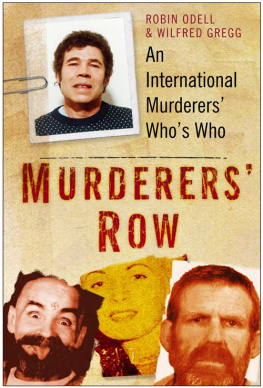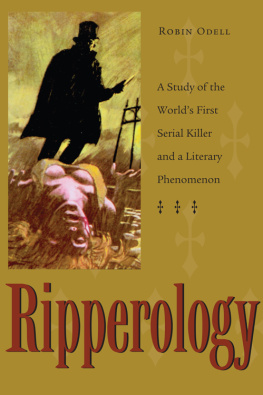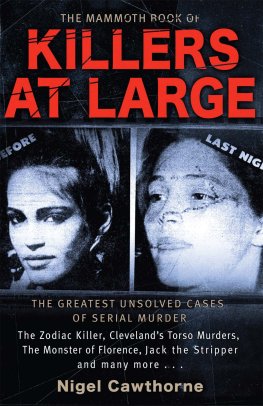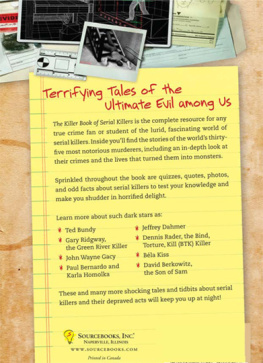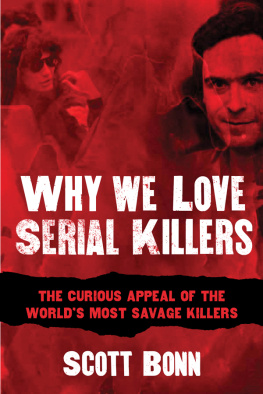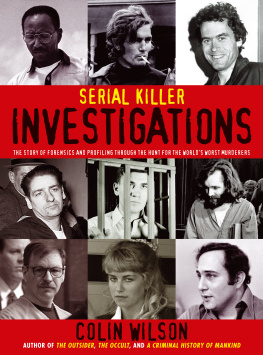M URDERERS
R OW
Dedicated to the memory of Joan and Joy
MURDERERS
ROW
An International Murderers Whos Who
ROBIN ODELL & WILFRED GREGG
First published in 2006
The History Press
The Mill, Brimscombe Port
Stroud, Gloucestershire, GL 5 2 QG
www.thehistorypress.co.uk
This ebook edition first published in 2011
All rights reserved
Robin Odell and Wilfred Gregg, 2006, 2011
The right of Robin Odell and Wilfred Gregg, to be identified as the Author of this work has been asserted in accordance with the Copyrights, Designs and Patents Act 1988.
This ebook is copyright material and must not be copied, reproduced, transferred, distributed, leased, licensed or publicly performed or used in any way except as specifically permitted in writing by the publishers, as allowed under the terms and conditions under which it was purchased or as strictly permitted by applicable copyright law. Any unauthorised distribution or use of this text may be a direct infringement of the authors and publishers rights, and those responsible may be liable in law accordingly.
EPUB ISBN 978 0 7524 7128 0
MOBI ISBN 978 0 7524 7129 7
Original typesetting by The History Press
C ONTENTS
A CKNOWLEDGEMENTS
We are pleased to acknowledge a debt of gratitude to Joe Gaute, crime historian of fond memory, whose inspiration it was to compile a Whos Who of Murder. The initial concept has been conveyed in various editions published over the last twenty-five years. Thanks are extended to Susan Fennell and the late Richard Floyd for providing a flow of press cuttings and crime references and to Loretta Lay and booksellers on both sides of the Atlantic for finding numerous crime titles.
The support and encouragement of Jonathan Goodman and Jeremy Beadle are gratefully acknowledged and thanks are due to the many faithful crime readers who have taken the time to write to us with information and comments.
N OTES
Subjects are listed in an A to Z format under their surname. The exceptions are those entries, such as the Mumbai Child Killings, which are better known by a popular reference.
An entry is referred to as a Case when a murder charge brought to trial has resulted in a lesser verdict or an acquittal. Unsolved murders are also listed in this way. At the conclusion of each entry are reference numbers relating to an extensive Select Bibliography. It is hoped that this will enable readers interested in a particular case to follow it up in greater detail in other books.
A UTHORS I NTRODUCTION
Like much else in the modern world, murder has changed and, generally speaking, not for the better. The nature and circumstances of acts of murder have evolved from the quiet domesticity of murder in the parlour for discernible motives, through an era of guns and gangsters, to lust killings and, seemingly motiveless, bizarre bloodletting. Dorothy Dunbar, the American writer, put it rather well in her book, Blood in the Parlor, published in 1964 when she wrote, On the rim of the twentieth-century loom the Titans Seddon, Armstrong, Crippen, G J Smith and Landru, and then, in the era of booze and bullets, art descends literally to hack work. And so, crimes marches on.
On the cusp of the twenty-first century, then, we are witness to murders committed less for recognisable motives such as gain or elimination and more for the sheer love of killing. Inflicting pain and exercising control over others to the point of death has become a kind of addiction that is almost commonplace in news reporting and has been transformed into the stuff of cinematic entertainment. The tentacles of this fascination with violence have spread to the internet where suicide and murder can be procured on demand.
In May 2004, a fourteen year old boy in Manchester recruited another teenager over the internet to murder him in what turned out to be a failed attempt. In the same year, Armin Meiwes, a German computer expert was convicted of manslaughter in a case involving a masochist he met through the internet who wanted to die. Meiwes obliged by killing Bernd Brandes, cutting up his body and resorting to cannibalism. Following an appeal against the verdict, Meiwes is to be retried. The case had echoes of Albert Fish in the 1930s who ate part of his victims flesh stewed with vegetables.
Murder has captured the public imagination with renewed fervour in the first decade of the new century. A measure of this is the way that programmes about crime, both fact and fiction, dominate the television schedules. Crime Scene Investigation (CSI), a highly successful formula from the USA, has introduced a new culture depicting the relationship between crime and science with dramatic realism. It provides entertainment, lauds the wonders of forensic science and adds a touch of morality with the notion that crime does not pay. CSI represents a world where murders are solved in the laboratory by forensic experts rather than in the library so beloved of Hercule Poirot.
Patterns of murder continue to change and where Bogota in Colombia was once considered to be the murder capital of the world, a fall of 20% in the murder rate was reported in 1997. Washington DC now tops the murder league with 50.82 deaths per 100,000 of population reported in 1979/99. By contrast, London reported 2.36 murders per 100,000 of population for the same period.
There was good news overall for the USA on the murder front in 2000. The FBI reported that the murder rate had dropped to a thirty-three year low. New York City in particular recorded a drop of 40% during the four years of Mayor Rudi Giulianis administration. For the first time in thirty years there were fewer than a thousand murders a year in the city. Similar trends were noted in all of the ten largest US cities. The improvements were attributed to zero tolerance policing, better enforcement strategies, more officers on the streets and more criminals behind bars.
Baltimore was the exception to the improving trend, with the highest per capita murder rate in the USA. This was attributed to the prevailing drug culture which led to shootings in the streets, literally assassinations, as drug barons defended their territories. Nearly 90% of the killers had criminal records and were aged between sixteen and twenty-eight.
Richard Rosenfield, an American criminologist, has commented that the dramatic increase in prison numbers had taken many potential offenders off the streets. Between 1980 and the mid 1990s, the rate of imprisonment increased threefold and in 2000, there were two million inmates in the US penal system. Also in 2000, there were 3,500 prisoners on Death Row and 800 executions have taken place since 1976 when the moratorium on the death penalty was lifted by the US Supreme Court. The USA executes more prisoners than any comparable industrialised nation. The death penalty is authorised in thirty-eight states with Texas accounting for nearly half of the annual total in 2002. Gary Heidnik, Aileen Wuornos and Karla Faye Tucker were executed between 1998 and 2002 after spending a combined total of thirty-seven years on Death Row.
Firearms play an increasingly dominant role in murder, particularly in gangland violence, while the proliferation of guns makes all types of killing easier and has introduced new definitions to the language such as Drive-by shootings, Walk-up shootings and Road rage killings. The firearms toll in the USA is thirty times greater than in Britain. Every day, four American citizens die in gun incidents. There are 65 million gun owners in America and in 2005 advertisements appeared in British newspapers advising travellers to the USA, particularly Florida, to be alert for road rage attacks involving guns. A new law in the Sunshine State allows citizens to use a gun if they feel threatened.

